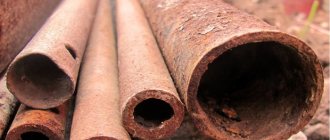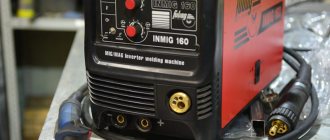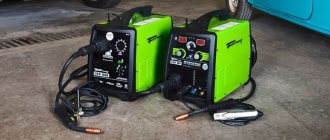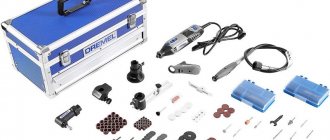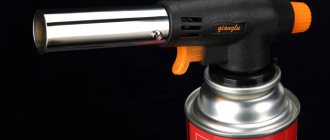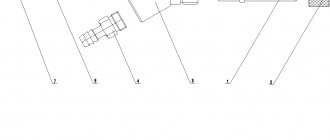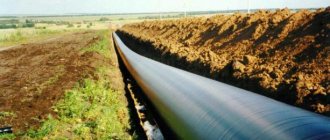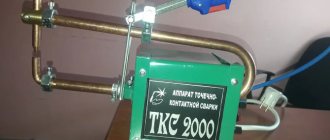Passive and active methods of protection
All main methods of protecting pipelines from corrosion come down to performing a number of works. If we talk about passive methods, they are expressed as follows:
- a special installation method, when resistance to corrosion is thought out at the stage of pipeline installation. To do this, an air gap is left between the ground and the pipe, thanks to which neither groundwater, nor salts, nor alkalis will get inside the pipeline;
- applying special coatings to pipes that will protect the surface from soil influences;
- treatment with special chemicals, for example, phosphates, which form a protective film on the surface.
A protection scheme based on active methods involves the use of electric current and electrochemical ion exchange reactions:
- electrical drainage protection to combat stray currents;
- anodic protection, which slows down the process of metal destruction;
- cathodic protection, when direct current increases the resistance of metals.
How zinc protects iron from corrosion
A thin film of zinc provides active (cathodic, electrochemical) and passive (barrier) protection of metals from rust. Without anti-corrosion protection, metal begins to oxidize under the influence of oxygen and water. Oxidation leads to the formation of rust, which can completely destroy the iron. Zinc forms a thin film on the surface of metals, protecting the material from the influence of the external environment. The zinc coating prevents the effects of oxygen even if the integrity of the protective film is damaged.
Galvanizing also provides electrochemical protection to metal structures. Zinc, forming a galvanic couple with iron, is a more active metal. When in contact with moisture and oxygen, the electrons of the zinc anode react, protecting the cathode metal.
Ways to combat corrosion
Metal corrosion is a destructive, lattice-destroying, redox chemical process. It is most often caused by the high chemical activity of the metals themselves - many remember from the school chemistry course the “line” of the activity of elements. It can be activated when unfavorable conditions are created, for example, high humidity and low temperatures, in an aggressive salt, acidic or alkaline environment.
Most often we have to deal with corrosion of ferrous metals, that is, various types of steel and cast iron, used literally everywhere, in all spheres of human activity. The process begins to reveal itself by the appearance of red stains or stains on the metal surface.
If corrosion is not dealt with, it can show its extremely destructive power - metal products quickly become unusable.
If no steps are taken, the outbreak begins to grow, capturing more and more areas. And sometimes this happens unnoticed. Thus, many areas of mechanisms, instruments, etc. - are simply hidden from view, and can only be seen when the unit or entire device is completely disassembled. And other pockets of corrosion may be hidden under a layer of paint for the time being, and only when the process has gone very far - first appear in the form of swellings, and then as rust breaks out.
Some owners try to deal with identified pockets of corrosion mechanically. That is, by grinding the damaged area with sandpaper or special discs, reaching the “healthy” metal.
However, such a technique, if it can be applied, should be done with extreme caution, and only as a preliminary step, before applying special compounds. Only mechanical cleaning is a very ineffective means
Spot corrosion showing through the paint layer
It is especially difficult to remove small pinpoint rust using this method, since during the cleaning process they become clogged with finely dispersed corrosive dust, and they become practically invisible. But the trouble is that they don’t go away, and will definitely show themselves in the future, even after coloring. Therefore, chemical treatment is more reliable.
In addition, if thin metal is affected by rust, then during cleaning, under the pressure of brushes or abrasive material, it can be damaged down to a through hole.
In this regard, it is recommended to use chemical compounds that clean the metal and prevent the occurrence of corrosion in the future. Moreover, with their help, you can even successfully deal with outbreaks in hard-to-reach areas, where you cannot reach the affected area by any other means without disassembling the mechanism.
Methods for protecting metal products from corrosion
There are several main ways to protect metal products from corrosion:
- metal alloying;
- protective coatings (metallic, non-metallic);
- electrochemical protection;
- changes in the properties of the corrosive environment;
- rational product design.
1. Alloying of metals.
This is one of the truly effective ways to increase the rust resistance of metals. During the alloying process, alloying elements such as chromium, nickel, molybdenum, etc. are introduced into the alloy or metal. They lead to passivation of the metal, that is, the metal or alloy goes into a state of increased corrosion resistance due to inhibition of the anodic process. The passive state of the metal is achieved due to the formation of an oxide film of perfect structure on its surface. It provides product protection only if the crystal lattices of the metal and the resulting oxide are as similar as possible to each other.
We recommend articles on metalworking
- Steel grades: classification and interpretation
- Aluminum grades and areas of their application
- Defects in metal products: causes and search methods
Alloying is actively used to protect, for example, embedded parts from corrosion. This treatment is carried out for iron, aluminum, copper, magnesium, zinc and alloys based on them. The resulting alloys, in comparison with the original metals, are characterized by increased corrosion resistance, as well as heat resistance and heat resistance.
Heat resistance is the ability of a metal to retain its properties even at high temperatures, when the likelihood of gas corrosion increases.
VT-metall offers services:
Heat resistance – preservation of high mechanical strength by a structural material at a significant increase in temperature. This property is usually achieved by alloying metals and alloys. Thus, steel is alloyed with chromium, aluminum and silicon. At high temperatures they oxidize first, resulting in the formation of dense protective oxide films, such as Al2O3 and Cr2O3.
In addition, alloying makes it possible to reduce the rate of electrochemical corrosion, especially when it is accompanied by the release of hydrogen. A striking example of corrosion-resistant alloys are stainless steels, where the role of alloying components is played by chromium, nickel and a number of other metals.
Types of corrosion
Over the entire period of working with metal products, people have identified several types of metal corrosion:
- Soil corrosion is a type of corrosion that affects structures located in the ground. Due to the special composition of the soil and the presence of groundwater, chemical processes occur that cause rust.
- Atmospheric - an oxidation process that occurs during contact of air water vapor with a metal surface. The more harmful substances in the air, the faster corrosion will appear.
- Liquid - metal structures located in water are susceptible to this type of corrosion. If the liquid contains salt, the process of destruction of the material will proceed faster.
The choice of anti-corrosion composition depends on the environment in which the metal part will be used.
Corrosion characteristics
Therefore, it is necessary to immediately discuss what corrosion is? This process is a specific chemical reaction. It occurs only when favorable conditions appear for this process.
Corrosion can appear on various metal surfaces if:
- the material will interact with water over a certain period of time,
- when the metal surface is in an open area,
- If all operating conditions have not been met, the metal itself is deformed, and its properties change so much that it becomes unsuitable for further use.
The metal, undermined by the external environment, crumbles and changes color and texture.
a brief description of
Safety glasses are an integral part of production processes, laboratory research, and are constantly used during construction work. They protect the face from splashes of hot metal, welding, droplets of aggressive liquid, infrared and ultraviolet radiation. In addition to glasses, there are also screens that look like a plate, rounded at the edges, with a head mount. There are a great variety of devices. They can have an elongated shape to protect the neck, and additionally be equipped with a plastic visor to hide the frontal part.
Impact-resistant materials are used in the manufacture of products: organic glass, polycarbonate and others. They are not afraid of chemical and mechanical damage, withstand significant temperature changes, providing one hundred percent visibility.
Some difficulties may arise when using personal protective equipment:
- field of view may be limited;
- Prolonged wear may cause discomfort;
- fogging of glass when working in hot shops.
In the production of face shields, modern high-tech equipment and high-quality and reliable materials are used that meet all safety requirements. A technology is used that makes it possible to use structures in any climate.
A distinctive feature of the product is its low weight to completely eliminate the load on the neck and head. The shield should not cause irritation or allergies during prolonged use. The best popular models have soft hypoallergenic pads for wearing comfort. Durable and high-quality fasteners do not put pressure on the head.
The screens are 100% transparent and completely eliminate optical distortion, which makes it possible to increase productivity, improve the quality of products, and avoid eye fatigue during long-term work. Some models provide the ability to wear additional protective equipment: respirators, headphones, and so on.
Safety at work
In order to most effectively eliminate the likelihood of poisoning and illnesses arising from work related to the application of paint and varnish coatings, you will be required to strictly follow safety regulations.
First of all, in the rooms where work will take place, it is necessary to ensure good ventilation. Then, if this is a large room, then the people performing paint and varnish work must be provided with all the necessary personal protective equipment - that is, mittens and overalls.
Moreover, special attention from this list should be paid specifically to respiratory protection equipment - that is, masks and half masks - respirators. Also, you or your workers should remember about personal hygiene. To clean your hands from paint and varnish materials, you can use special cleaning pastes. But under no circumstances use solvents to clean the skin, as this leads to the appearance of a rash on the skin, as well as various allergic irritations.
In order to promptly identify various diseases of this nature, it is necessary that people who do paint and varnish work undergo periodic medical examinations in order to prevent the occurrence of these dermatological diseases.
Types of corrosion
Scientists have been fighting corrosion for a long time and have identified several main types:
- Atmospheric. Oxidation occurs due to contact with air oxygen and water vapor contained in it. The presence of pollutants in the air in the form of chemically active substances accelerates rusting.
- Liquid. It takes place in an aquatic environment; salts contained in water, especially sea water, accelerate oxidation many times over.
- Soil. Products and structures located in the ground are susceptible to this type. The chemical composition of the soil, groundwater and leakage currents create a special environment for the development of chemical processes.
Based on the environment in which the product will be used, suitable methods of corrosion protection are selected.
Traditional methods of removing rust
In addition to factory-made preparations, so-called folk recipes can be used to remove rust. Most often we are talking about the drink “Coca Cola”, the cleaning product “Cilit” or a mixture of kerosene and paraffin.
Below is more information about each of the tools:
- The effectiveness of the Coca Cola drink against rust is associated with the presence of orthophosphoric acid in the drink. To remove rust, you need to apply the drink to the problem area. You can use a soaked rag or a piece of foil. The method of immersion in a container with a drink is also used.
- "Cilit" is often used to remove rust from household appliances in bathrooms and kitchens. At the same time, the cleaning agent can be used to remove traces of corrosion on other metal objects, for example, car parts. However, it should be borne in mind that this product can corrode paint.
- You can also clean the surface from rust with a solution of kerosene and paraffin in a ratio of 10 to 1. Before use, the composition must be kept for 24 hours. Next, the mixture is applied to the rusty area for 12 hours. The procedure is completed by cleaning the surface with a rag.
When handling chemicals, safety precautions must be observed. First of all, it is necessary to protect the skin, respiratory and vision organs from hazardous particles. You will need a respirator, safety glasses and gloves.
M
Methods of combating iron corrosion, or simply rust, have a history no less long than the history of iron itself.
Even the Vikings, when sailing on a raid, generously greased their steel swords and chain mail to protect them from sea water. Without this, rust would have eaten away the metal before the first battle.
Nowadays, the most common way to protect against corrosion is to paint the metal with special compounds.
Anyone who has ever held a paint brush in their hands will confirm that painting does not require much work. You can paint, say, a regular garage door in an hour and a half. Perhaps a little more, if you take into account the time for preparation and for washing the tool upon completion of the work.
But imagine that you need to paint not five to seven square meters, but thousands and tens of thousands, while getting a smooth, durable coating? Here you can’t get by with a brush; completely different solutions and tools are required.
Let's take a tour of the paint shops and see how modern engineers cope with this difficult task.
Varieties and classification
Metal paints that are used to protect against the appearance and development of corrosion are divided into the following types:
For example, enamel primer for metal. Paints of this group are most effective for application to structures that are constantly in water or in the open air. The dye is a fast-drying substance. It dries completely within 2-3 hours after application to the surface to be treated.
Passivating
The purpose of such primer-paint is to slow down the development of corrosion. The advantages include high efficiency in slowing down oxidative processes. Due to this property of the paint, it is used in places of high humidity.
Converter
The composition includes phosphoric acid. After contact with corrosion, it forms a strong and stable iron phosphate. Thanks to this property, the paint not only protects the structure from rust, but also partially restores damaged areas.
Two-component phosphating agent
It consists of phosphoric acid and passivating additives, this makes it possible to use the product to protect galvanized structures from corrosion.
A quick-drying and economical primer-paint. Its anti-corrosion properties make it possible to paint products in conditions of high humidity. It contains dissolved tiny metal particles. After complete drying, it forms a durable and reliable metallized coating.
It has high anti-corrosion and adhesive properties. Thanks to the unique formula of the composition, when applied to an area affected by corrosion, it acts as a primer.
Thanks to them, the object not only becomes immune to corrosion, but also significantly improves the appearance of the metal structure.
Manufacturers produce anti-corrosion paints, which are divided into the following classifications:
Epoxy enamels
The synthetic resins from which the dye is made protect metal structures from exposure to high temperatures. The toxicity of the components included in the composition does not allow the frequent use of enamels in everyday life.
Oil paints
A dye based on natural drying oil. Painting structures located outdoors is not so effective. Oil paints cannot provide adequate protection against corrosion and subsequent destruction.
Alkyd paints
Substances intended for painting galvanized surfaces, resistant to high temperatures and flammable
When working with them, it is important to follow safety precautions and protect the dye from exposure to open flames.
Acrylic dyes
Despite their recent appearance on the market, they quickly gained popularity. Effectively and reliably protect metal structures from destruction. Used for both interior and finishing work.
Hammer paints.
The characteristics of this coloring substance make it possible to obtain a rough surface with a pronounced metallic sheen. Among the components in the composition are alkyds, epoxides, aluminum powder and acrid. The features of hammer paint include the ability to be used to protect non-ferrous metals. There is no need to use a primer when processing this material. The dye is applied in three layers: the first acts as a primer, the anti-corrosion coating is implemented in the second layer. The third one acts as enamel. Hammer paint cannot be used to treat metal products that will subsequently heat up above 150 °C during use.
Rust converters for protecting metal structures from corrosion
The company's product range includes a material with rust converter properties - AKTERM Plast Primer-Enamel 3 in 1 - one of the three properties is rust conversion, in addition to enamel and primer. When working, it is necessary to apply the material to a pre-treated surface, removing loose rust using handy means that allow you to “sand” the surface.
AKTERM Primer-enamel Plast
A one-component, quick-drying decorative coating, used as anti-corrosion protection for metal structures, bridges, cell phone towers, ship hulls, vehicle bodies and rolling stock operating under conditions of external climatic factors. Weather resistance up to 10 years. Colored in RAL. Universal anti-corrosion protection of metal
Read more
Protective paints for metal
According to the operating temperature conditions, paints are divided into two large groups:
- conventional, used at temperatures up to 80 °C;
- heat resistant.
Based on the type of binder base, the paints are:
- alkyd;
- acrylic;
- epoxy.
Paint and varnish coatings for metal have the following advantages:
- high-quality surface protection against corrosion;
- ease of application;
- quick drying;
- many different colors;
- long service life.
Hammer enamels are very popular, not only protecting the metal, but also creating an aesthetic appearance. Silver paint is also common for metal processing. Aluminum powder is added to its composition. Metal protection occurs due to the formation of a thin film of aluminum oxide.
Silver paint
Two-component epoxy mixtures have exceptional coating strength and are used for components subject to high loads.
Protection of metal from corrosion by galvanizing in Steelproff
Advantages of ordering galvanizing at Metalbase Steelproff:
- Application of modern equipment and advanced technologies for anti-corrosion protection of metals.
- Work is carried out by qualified workers with extensive practical experience.
- Selection of the most profitable iron processing technology.
- Delivery of finished products in St. Petersburg, Leningrad region, and other regions of Russia.
Order metal galvanizing from our company -
We guarantee high-quality performance of work within the agreed time frame!
Which rust converter is best to buy?
As you can see, all rust converters for cars cope with the task assigned to them to one degree or another. Some turn the damaged area into soil, others form a protective film and prevent the lesion from growing. However, the most important condition for their effective action is strict adherence to the rules for applying the drug and preparing the surface to be treated as specified by the manufacturer.
Depending on the quality of the effect and the method of application of the product, the following conclusions can be drawn:
- Many car owners consider the American-made Hi Gear aerosol to be the most effective rust converter.
- Among the domestic products, the highest quality and most effective drug is the rust converter Tsinkar.
- If you have to treat a small surface against corrosion, you should opt for Fenom FN956.
- Liquid rust converter “Khimik” is suitable for those who need a large amount of product to treat a surface significantly damaged by corrosion.
- The ability to remove rust in hard-to-reach places is guaranteed by Astrochem aerosol.
- For those who value not only quality, but also a convenient method of application, without bubbles or drips, the Permatex gel rust converter is suitable.
This rating examined the 6 best rust converters for cars, and all of them protect the vehicle from corrosion quite well. But here is the main advice that experienced mechanics give: when fighting iron oxidation, you should not delay treating the damaged surface for too long; it is better to neutralize small lesions than to restore large areas.
Video description
How to remove rust using Silit, watch this video
Some home craftsmen use Coca-Cola or Pepsi to get rid of corrosion. These drinks contain phosphoric acid, which easily removes small rust stains. Wipe metal surfaces with liquids or immerse parts in them. Then rinse under running water.
Pepsi can easily cope with rust in small areas Source yandex.net
A mixture based on paraffin and kerosene is also popular. Take these products in equal proportions and mix. Apply to the surface to be treated in several thin layers with a sponge or brush. Leave it for at least a day. After the specified time, remove the mixture along with the rust with a rag, rinse with water and remove moisture with a rag or sponge. It is best to use this method for tools. Do not forget about a mask, gloves and safety glasses when processing with a kerosene-paraffin mixture.
Inhibitor compositions
Most often, compositions based on sodium nitrite are used, which are added to sodium silicates and phosphates, brines, sodium bichromates, sulfoxides, amines, tannin, etc.
Moreover, when using one or another inhibitor, it is important to take into account that the defense reaction involves its consumption, therefore it is periodically necessary to introduce new portions of the active element into the aggressive environment. For example, a typical composition of a corrosion inhibitor based on sodium nitrite is added in a volume of up to 0.05%
Also, the active groups of compounds behave differently in certain environments. So, if the task is oxidation, then hydroquinone is taken as a basis, and to delay rust processes in relation to steel alloys, the use of technetium is recommended. Specialized compounds include inhibitors for protection in environments with chlorine and hydrogen. In this case, nitrogen trichloride is used, but in minimal doses. As a rule, a thousandth of the total amount of reagents is enough to stop a negative interaction.
The best hammer paints for rust
Hammer paints form a specific rough coating, creating the effect of being hammered. At the same time, the enamel perfectly protects against moisture and temperature changes. After assessing the technical characteristics and feedback from specialists, 2 winners were selected that met the necessary requirements.
Hammerite
...I used enamel to paint a metal door to evaluate the strength of the hammer effect. Hammerite well masks unevenness that has arisen during the use of the canvas and creates a visually impressive coating... Expert opinion
Another best anti-rust paint to protect metal during both exterior and interior work. It adheres well to substrates with signs of rust due to its high adhesion rate. The enamel creates a smooth coating with excellent water-repellent properties even on a rusty, unprepared surface and completely hardens within 2 hours after application. The product has excellent heat resistance, maintaining its integrity even when heated (up to 80°C).
Hammerite is designed to protect ferrous metals exclusively. It contains corrosion-inhibiting components - alkyd varnish, sunlight-resistant pigments and functional additives. It is allowed to start painting when the air is heated to 5°C with a roller, brush or spray, which allows you to choose the most convenient tool in each specific case. After applying the base coat, wait at least 5 hours. The manufacturer offers 11 shades.
Advantages
- Resistance to aggressive factors;
- Ease of application to corrosion areas;
- Does not require preparatory work;
- Suitable for outdoor and indoor work;
- Lead free.
Flaws
- Not low cost;
- Hammerite solvent is required for dilution.
Zip Guard
This is a urethane rustproof paint designed for metal surfaces, but it is also suitable for concrete and wood. Enamel can be used directly in areas with signs of corrosion. In this case, it is not necessary to carry out any actions to clean the affected areas, except in cases where there is swelling of the old coating - they must be removed.
In the production of Zip Guard, the Ziprust technology is used, which allows you to apply a layer without the prior use of primers. Enamel can be used for interior and exterior work. It is a one-component composition and creates a corrosion-resistant coating due to the combination of the properties of the soil, anti-corrosion components and the finishing composition.
Advantages
- Protection of all types of surfaces, not just metal;
- There is no need for surface preparation;
- Suitability for external and internal work;
- Creation of a durable coating with anti-corrosion properties.
Flaws
- Glossy surfaces must be sanded before painting;
- It takes a long time to dry.
Anti-corrosion protection - why is it needed?
Corrosion is a process accompanied by the destruction of the surface layers of steel and cast iron structures, resulting from electrochemical and chemical influences. The negative consequence of this is serious damage to the metal , its corrosion, which does not allow it to be used for its intended purpose.
Experts have provided sufficient evidence that every year about 10% of the total metal production on the planet is spent on eliminating losses associated with the effects of corrosion, which causes the melting of metals and the complete loss of operational properties of metal products.
At the first signs of corrosion, cast iron and steel products become less airtight and durable. At the same time, qualities such as thermal conductivity, plasticity, reflective potential and some other important characteristics deteriorate. In the future, the structures cannot be used at all for their intended purpose.
In addition to this, the majority of industrial and domestic accidents, as well as some environmental disasters, . Pipelines used to transport oil and gas that have significant areas covered with rust can lose their integrity at any time, which can pose a threat to human health and nature as a result of a break in such pipelines. This gives an understanding of why it is so important to take measures to protect metal structures from corrosion, using traditional and new means and methods.
Unfortunately, it has not yet been possible to create a technology that could completely protect steel alloys and metals from corrosion. At the same time, there are opportunities to delay and reduce the negative consequences of such processes. This problem is solved through the use of a large number of anti-corrosion agents and technologies.
The corrosion control methods proposed today can be presented in the following groups:
- Use of electrochemical methods for protecting structures;
- Creation of protective coatings;
- Development and production of the latest structural materials that demonstrate high resistance to corrosion processes;
- Adding special compounds to a corrosive environment that can slow down the spread of rust;
- A competent approach to choosing suitable metal parts and structures for the construction industry.
Use of inhibitors at home
For general users, the most affordable means of corrosion protection using inhibitors is to apply a primer compound to the target surface. This is a lightweight inhibitory coating, the effect of which is to prevent direct contact of water or an aggressive solution with the metal surface. Often paints and varnishes contain similar corrosion inhibitors. Substances used for such purposes are produced in factories. These include red lead for the same primer, solutions of zinc or iron orthophosphates, phosphate coatings, etc.
Methods for removing rust
Cleaning metal from rust
You can use several proven techniques to effectively extend the service life of metal elements.
Chemical treatment brings the best results.
You can use inhibitor compounds that cover metal products with a thin film, preventing the destruction process.
Often such drugs are used for prevention.
Let's look at the main ways to remove rust:
- Mechanical removal.
- Chemical treatment.
- Special anti-corrosion agents.
- Old folk methods of removing corrosion.
How is mechanical removal performed?
For mechanical processing, a brush or abrasive sandpaper with coarse grain is suitable. Cleaning can be done dry or wet. Let's look at the tools that can be used for mechanical cleaning:
- Grinder with special abrasive wheels.
- Sandblasting installation.
- Electric drill attachments.
- An ordinary grinder with an emery disc.
The use of a brush or sandpaper is justified on complex, hard-to-reach surfaces. They allow you to remove small fragments of rust that powerful tools that work mainly on a smooth surface cannot reach.
A special attachment for a drill or grinder greatly increases the speed of work. Such methods cannot be called highly accurate, since a large layer of metal is removed along with the rust.
The optimal mechanical means for removing corrosion is sandblasting. The powerful pressure of sand knocks off all rust from the surface and can penetrate into hard-to-reach places.
Chemical cleaning
Chemical methods involve the use of the following agents:
- Rust converters.
- Acids.
- Traditional medicine.
How to lubricate metal to prevent it from rusting: the classic remedy is orthophosphate acid. Mode of application:
- A thin layer of acid is poured onto the rusty area.
- They wait for half an hour.
- Wipe the treated surface dry.
Orthophosphate acids eliminate rust and promote the formation of a water-repellent film. The resulting film inhibits the oxidation process of metal elements and prevents the subsequent spread of corrosion.
To remove rust, a 30% acid solution is used. Orthophosphate acid does not react as aggressively with metal as other agents.
Using rust converters
One of the common manufacturers, Rocket Chemical, provides a wide range of anti-corrosion products. The most effective are:
- Inhibitor with a prolonged effect. Treated metal fixtures can be left outdoors for a year without any problems. They can be protected from the destructive effects of the environment.
- A protective lithium mixture is applied to the metal for protection and preventive purposes. Often used to remove corrosion from door hinges, cables, chains, and various rack and pinion mechanisms. Forms a protective film that is not washed off by rain.
- The waterproof silicone substance can be used not only on metal, but also on vinyl and rubber. Dries quickly and forms a thin coating to protect materials.
- Anti-rust spray. It is used to process hard-to-reach elements, penetrates deeply, and protects materials from rust. Used for treating threaded connections and screws against rust.
Folk remedies
How to coat metal against corrosion if it is not possible to purchase an expensive tool or chemical. For this purpose, the people have long had several proven methods. Solutions of hydrochloric and sulfuric acid diluted in water help get rid of rust.
Folk remedies for rust
The created substance contains an acid corrosion inhibitor that inhibits the chemical reaction. This inhibitor prevents the acid from interacting with the metal oxide and hydroxide that make up the rust itself.
If you add a little hexamine to the product, you can immerse window bolts, small bicycle parts, nuts and bolts in them. This product is applied to large objects using a regular brush.
To prevent acidic agents from dissolving the iron itself, it is better to add an inhibitor to them. Potato tops can serve as just such an additional tool. For this purpose, potato leaves are poured with a 5-7% solution of hydrochloric and sulfuric acid. When the product has infused for 20 minutes, the acid is drained and used when processing metal products.
How to protect metals from corrosion and rust - on video:
Noticed a mistake? Select it and press Ctrl+Enter to let us know.
It is almost impossible to completely prevent the formation of metal corrosion: sooner or later the metal will begin to rust. At the same time, there are ways to significantly extend the service life of the material if you follow the rules of operation of the metal product and use special products that slow down corrosion processes. If rust has already appeared, it must be removed (by chemical or mechanical means) to prevent corrosion processes from developing.
Primers and phosphating against metal corrosion
The second type of corrosion protection is to apply a small amount of primer under a layer of varnish or paint. The elements that make up it must also have inhibitory properties. If this condition is met, water will pass through the primer layer, dissolving a certain amount of pigments, thereby becoming less aggressive. Red lead is recognized as one of the most effective elements for soils.
There are cases when, instead of a primer, the surface of metal products is phosphated. This process is carried out by applying to the required area solutions of manganese (II), iron (III), or zinc (II) orthophosphates, which also contain orthophosphate acid itself. It is worth noting that phosphating is carried out for 30-90 minutes at a temperature of 97-99 C.
To carry out phosphating of steel surfaces, there are a large number of special preparations that consist of iron and manganese phosphates. Many experts note. That the most effective such remedy is “mazhef” - a mixture of dihydrogen phosphates of manganese, iron and phosphoric acid.
If phosphating is carried out using this drug, the product must be placed in a special solution heated to 100C. Inside the mixture, harmful elements are removed from the surface of the metal with abundant release of hydrogen, resulting in a strong, dense and almost insoluble layer of iron and manganese of black-gray color. As soon as the layer thickness reaches a certain level, the dissolution of substances stops.
The phosphate film turns out to be effective in protecting the structure from atmospheric agents, but is not able to protect even from weak acid solutions. From all that has been said, we can conclude that the phosphate layer of protection can only serve as a foundation for the further application of decorative and protective coatings.
Types of anti-corrosion coatings
There are many types of protection against rust in the modern world. The types of such anti-corrosion coatings include:
- Enamel three in one. The name of this paint means that it can be applied directly to rust. It is recommended to clean only the top, loose layer of corrosion.
- Primer. This special anti-corrosion coating is used for metal, more precisely used to prevent rusting before applying a layer of regular paint. This species is divided into two subspecies:
- For normal surfaces. These include surfaces that have excellent roughness so that the soil can adhere well to the surface.
- For problematic surfaces. These include products made from duralumin, aluminum, copper, and alloys made from anti-corrosion materials.
- Protective primers. Such coatings contain zinc powder, which protects the structure.
- Insulating primers. They protect the steel from moisture penetration.
Anti-corrosion primer
Before applying an anti-corrosion coating, it is necessary to follow some rules in order not to damage the product (if a protective layer of paint is applied to a galvanized surface), so that the film adheres tightly and does not peel off at the first touch of harmful atmospheric substances.
What to look for when choosing a rust converter?
To choose the best neutralizer, you should pay attention to several basic criteria:
- Subject of processing. If the product is intended to process metal for painting, it is best to purchase a simple converter. To prepare the structure for a new paint coating, a converter for the car body is suitable. If a more reliable treatment is needed, it is worth purchasing a neutralizer with a primer effect that covers the metal with a protective film - such a layer prevents corrosion and levels the base for further painting.
- Release form. The choice of a specific consistency of the product depends on the type of surface being treated - a wide horizontal area, vertical, hard-to-reach place or small metal parts. It depends on this which form of release will allow you to most comfortably treat a particular area, whether it will be a liquid, gel or spray.
- Rust thickness. The deeper the corrosion layer, the more difficult it is for the converter to cope with it. The ideal result is achieved when working with shallow layers of metal damage - 0.01 mm or less. A thicker layer of rust requires a longer surface treatment process.
Mechanical removal
To mechanically treat rust, you will need a metal brush or coarse abrasive sandpaper. Using sandpaper, you can clean the material using the “dry” method or the “wet” method (wetting the sandpaper with kerosene or white spirit).
Other mechanical cleaning options include the use of the following hardware:
- orbital sander with abrasive wheels;
- sandblasting machine;
- electric drill attachments;
- Bulgarians.
The use of manual means (brush or sandpaper) is justified on small surfaces. The advantage of working the surface by hand is that it allows you to go more thoroughly into small or hard-to-reach areas.
An attachment to an electric drill, grinder or grinder can speed up surface cleaning significantly. However, such methods are not highly accurate: too much metal is removed.
Sandblasting equipment is the best way to remove rust.
Removal of corrosive products occurs by treating the metal with a powerful jet of sand. In this case, the undamaged metal completely retains its structure.
The disadvantage of this method is the high cost of new equipment.
Which rust converter is best to buy?
The modern market offers a huge range of corrosion removal products. However, which product is best will depend on the type of work to be done. If you want a super durable coat that will last for a long period of time, then we recommend Permatex, which also works like a primer.
If you are faced with the task of getting to deeply hidden pockets of corrosion, then pay attention to Autoprofi and Hi-Gear, which, thanks to convenient sprayers, will do all the necessary work. If you are looking for something cheap and time-tested, then Tsinkar is your choice
No matter which product you choose, never neglect protective equipment. The acidic composition of converters can adversely affect the eyes and respiratory tract.
Direct and indirect problems associated with metal corrosion
The main problem with corrosion is the gradual destruction of corroded parts of structures and products. At the same time, the degree of damage cannot always be assessed by appearance, and the loss of strength becomes unexpected and critical.
Intercrystalline corrosion, that is, passing along the boundaries of crystals, is especially strong. Externally, the process may be completely unnoticeable, while the level of strength loss reaches 50...60%.
Surface destruction has the least impact on the strength properties of products.
The photo shows part of the structures of the Shukhov Tower in Moscow. Surface rusting has significantly reduced structural strength, but has not led to the destruction of the structure (yet)
It is extremely difficult to estimate the level of losses from metal corrosion. The point is not even in direct losses from the destruction of corroded parts or structures, but in downtime of equipment and structures and disruptions in their performance as a whole, associated with the corrosion destruction of individual elements.
Protecting metal with metal
An iron part can be painted not only with paint or polymer, but also with a layer of another metal. Unlike iron, many metals, such as zinc and tin, are practically resistant to corrosion.
The shiny polished coating forms a thin layer of chrome or nickel. A variety of parts sport this coating, from nickel-plated water faucets to chrome-plated parts of motorcycles and cars.
No less common is tinning - coating with a thin layer of tin. Well-known tin cans are made from steel sheet coated inside and outside with tin. This treatment preserves not only the metal of the can, but also its contents.
The most common method for applying protective metal is the electrolytic method . The part is immersed in a bath of electrolyte, and under the influence of electric current, the coating molecules “stick” to the surface of the iron. Despite the fact that this layer is thinner than a human hair, it lasts for decades.

